-

人教版高中数学选修3分类加法计数原理与分步乘法计数原理(2)教学设计
当A,C颜色相同时,先染P有4种方法,再染A,C有3种方法,然后染B有2种方法,最后染D也有2种方法.根据分步乘法计数原理知,共有4×3×2×2=48(种)方法;当A,C颜色不相同时,先染P有4种方法,再染A有3种方法,然后染C有2种方法,最后染B,D都有1种方法.根据分步乘法计数原理知,共有4×3×2×1×1=24(种)方法.综上,共有48+24=72(种)方法.故选B.答案:B5.某艺术小组有9人,每人至少会钢琴和小号中的一种乐器,其中7人会钢琴,3人会小号,从中选出会钢琴与会小号的各1人,有多少种不同的选法?解:由题意可知,在艺术小组9人中,有且仅有1人既会钢琴又会小号(把该人记为甲),只会钢琴的有6人,只会小号的有2人.把从中选出会钢琴与会小号各1人的方法分为两类.第1类,甲入选,另1人只需从其他8人中任选1人,故这类选法共8种;第2类,甲不入选,则会钢琴的只能从6个只会钢琴的人中选出,有6种不同的选法,会小号的也只能从只会小号的2人中选出,有2种不同的选法,所以这类选法共有6×2=12(种).因此共有8+12=20(种)不同的选法.

人教版高中数学选修3分类加法计数原理与分步乘法计数原理(1)教学设计
问题1. 用一个大写的英文字母或一个阿拉伯数字给教室里的一个座位编号,总共能编出多少种不同的号码?因为英文字母共有26个,阿拉伯数字共有10个,所以总共可以编出26+10=36种不同的号码.问题2.你能说说这个问题的特征吗?上述计数过程的基本环节是:(1)确定分类标准,根据问题条件分为字母号码和数字号码两类;(2)分别计算各类号码的个数;(3)各类号码的个数相加,得出所有号码的个数.你能举出一些生活中类似的例子吗?一般地,有如下分类加法计数原理:完成一件事,有两类办法. 在第1类办法中有m种不同的方法,在第2类方法中有n种不同的方法,则完成这件事共有:N= m+n种不同的方法.二、典例解析例1.在填写高考志愿时,一名高中毕业生了解到,A,B两所大学各有一些自己感兴趣的强项专业,如表,
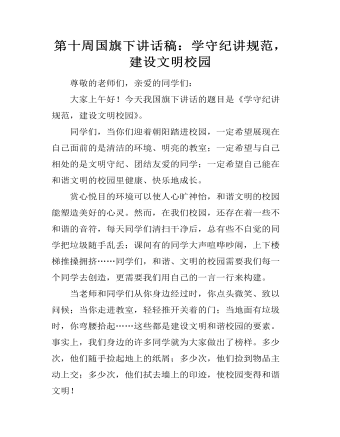
第十周国旗下讲话稿:学守纪讲规范,建设文明校园
尊敬的老师们,亲爱的同学们:大家上午好!今天我国旗下讲话的题目是《学守纪讲规范,建设文明校园》。同学们,当你们迎着朝阳踏进校园,一定希望展现在自己面前的是清洁的环境、明亮的教室;一定希望与自己相处的是文明守纪、团结友爱的同学;一定希望自己能在和谐文明的校园里健康、快乐地成长。赏心悦目的环境可以使人心旷神怡,和谐文明的校园能塑造美好的心灵。然而,在我们校园,还存在着一些不和谐的音符,每天同学们清扫干净后,总有些不自觉的同学把垃圾随手乱丢;课间有的同学大声喧哗吵闹,上下楼梯推搡拥挤……同学们,和谐、文明的校园需要我们每一个同学去创造,更需要我们用自己的一言一行来构建。当老师和同学们从你身边经过时,你点头微笑、致以问候;当你走进教室,轻轻推开关着的门;当地面有垃圾时,你弯腰拾起……
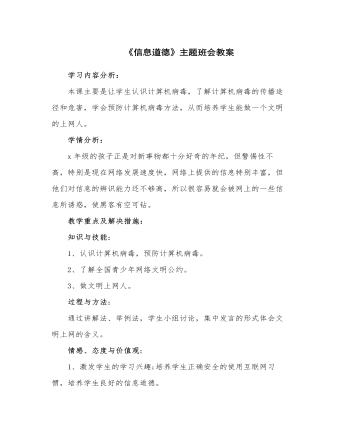
《信息道德》主题班会教案
过程与方法:通过讲解法、举例法,学生小组讨论,集中发言的形式体会文明上网的含义。情感、态度与价值观:1、激发学生的学习兴趣;培养学生正确安全的使用互联网习惯,培养学生良好的信息道德。2、培养探究意识、创新精神、竞争意识。教学重点:1、了解什么是计算机病毒及其特性,并如何预防。2、明确如何做一名文明上网人。解决措施:通过在网上百度搜索的图片(特别是有关QQ聊天时互传的文件,或网页上的引诱性很强的“陷井链接”经典图片)、阅读课文及将计算机病毒与生物病毒进行对比来了解什么是计算机病毒及特性。通过讨论及总结来了解预防计算机病毒的方法。通过讨论及举例来明确如何做一个文明上网人。以此来解决教学中的重点问题。
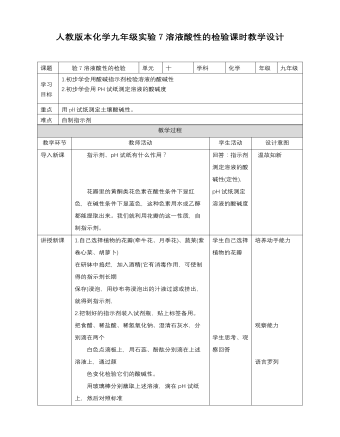
初中化学人教版九年级下册《实验活动7溶液酸碱性的检验》教案
1.自己选择植物的花瓣(牵牛花、月季花)、蔬菜(紫卷心菜、胡萝卜) 在研钵中捣烂,加入酒精(它有消毒作用,可使制得的指示剂长期 保存)浸泡,用纱布将浸泡出的汁液过滤或挤出,就得到指示剂, 2.把制好的指示剂装入试剂瓶,贴上标签备用。 把食醋、稀盐酸、稀氢氧化钠、澄清石灰水,分别滴在两个 白色点滴板上,用石蕊、酚酞分别滴在上述溶液上,通过颜 色变化检验它们的酸碱性。 用玻璃棒分别蘸取上述溶液,滴在pH试纸上,然后对照标准 比色卡比较,得出pH值,也就是酸碱度。 把上述溶液滴在白色点滴板上,用滴管吸一下你自制的指示剂,滴在滴板的溶液里,观察颜色变化,每用一种指示剂,换一下滴板的溶液。 把所得到颜色变色变化的信息和pH值数据填入教材第70页的表中。 3.取少量土壤样品,将土壤样品与蒸馏水按1∶5的质量比在烧杯中混合, 充分搅拌后静置,用玻璃棒蘸澄清的液体,滴在pH试纸上,然后对照 标准比色卡记录读数。

北师大版初中数学九年级下册船有触礁的危险吗说课稿
5、板书设计 §1.4船有触礁的危险吗 一、船布触礁的危险吗 1.根据题意,画出示意图.将实际问题转化为数学问题. 2.用三角函数和方程的思想解决关于直角三角形的问题. 3.解释最后的结果. 二、测量塔高 三、改造楼梯 五布置课后作业: 习题1.6第12 3题 六、设计说明 具有现实意义和挑战性的内容的设计,激发学生的学习兴趣,使学生乐学。 开放性实践问题和分层作业的设置,满足每个学生的学习需求,使学生愿学。 多样的学习方式和适时引导,提高学生的学习质量,使学生能学。 背景多样,层层递进,适时反思,发展学生的数学思维能力,使学生活学。 当学生乐学、愿学、能学、活学时,就将学会学习,将学习当成乐趣,作为生命中不可或缺的部分,也为学生终生学习奠定良好的基础。

人教版新目标初中英语九年级下册By the time I got outside, the bus had already left教案
Ⅰ. Teaching Aims and Demands1. Knowledge Objects(1) Key Vocabularyoversleep(2) Target LanguageWhat happened?I overslept. And by the time I got up, my brother had already gotten in the shower.2. Ability Objects(1) Teach the students to use the new words.(2) Train the students to narrate past events with the Past Perfect Tense.(3) Train the students' listening and speaking skills with the target language.3. Moral ObjectIt’s a good habit to go to bed early in the evening and get up early in the morning. So you’ll never be in a hurry in the morning.Ⅱ. Teaching Key Points1. Key Vocabularyoversleep2. Target LanguageNarrate past events with the Past Perfect TenseⅢ. Teaching Difficult Points1. Train the students to narrate past events with the Past Perfect Tense.2. Train the students to understand the target language in spoken conversation.Ⅳ. Teaching Methods1. Thinking of examples from the students' real lives.2. Making sentences by looking at the pictures.Ⅴ. Teaching AidA tape recorderⅥ. Teaching ProceduresStep I Revision1. Revise the language points in Unit 8.Ask some questions like this: What volunteer work would you like to do?Help the students to answer, I’d like to…/I love to…/I hope to2. Practice the dialogue in Activity 3c on page 62 again. Get students to role play the similar dialogues with the following.

人教版新目标初中英语九年级下册Rainy days make me sad教案
1. 教材分析本单元以how do things affect you?为话题, 从颜色、天气、音乐、广告、产品等方面谈论了外界事物如何影响人的心情。要求学生掌握表达某物或某事给人带来的感觉、看法或影响等。共设计了四个部分的内容:Section A 该部分有4个模块:第一模块围绕Which restaurant would you like to go to?这一话题展开思维(1a)、听力(1b)、口语(1c)训练;第二模块围绕How does music affect you? 进行听力(2a-2b)、口语训练(2c);第三模块继续围绕how do colors in the restaurant affect you这一话题展开训练,训练形式为阅读和问题体验(3a)和小组活动(3b);第四模块仍就How do things affect you这一话题以调查的形式展开讨论。Section B该部分有4个模块:第一模块围绕产品广告对人们的影响这一话题以“配对”(1a)与“列举”(1b)两种形式展开训练;第二模块继续围绕How do things affect you? 进行听力(2a-2b)、口语对话训练(2c);第三模块围绕“Advertising”这一话题展开阅读(3a-3b)和写作(3c)训练;第四模块围绕How posters affect you这一话题以口语训练形式展开小组活动。

人教版新目标初中英语九年级下册Could you please tell me where the restrooms are教案
Step Ⅰ RevisionCheck homework. Ask a few students to read the article in 3a.Then ask a few students to read their guides.Step Ⅱ Part 1Look at the words in the box. Ask a student to read them. Make sure the students understand the meaning of the words. You are to fill in the blanks with the words. In some cases, students may need to use another form of the word, for example adjusting for tense or subject/ verb agreement.Ask students to fill in the blanks on their own.Check the answers. Step ⅢPart 2Go through the instructions with the class.Look at the example with the students.Ask students what the answer would be.Ask a student to read the question and answer it.Excuse me, could you tell me where the bank is, please?The bank is across the street from the shopping malt.Get students to complete the work in pairs.Check the answers. Ask a few students to read their questions.Step Ⅳ Just for Fun!Ask all the students to read the conversation. Ask: What is funny about this cartoon? Help students to explain. A Martian is a person from the planet Mars.There is no such thing as Martian food on Earth, and the clerk looks silly because he is trying to think of where there is a Martian restaurant.Invite some pairs of students to present this conversation to the rest of the class.Step Ⅴ Summary and HomeworkIn this class, we’ve done much writing practice using the key vocabulary words and the target language presented in this unit. After class, please finish the questions in 2 in your exercise books. Then finish the exercises on pages 47~48 of the workbook as well.The Seventh Period Ⅰ Teaching Aims and Demands1. Knowledge Objects(1) Key Vocabularyimage, adventure, jealousy, hero, crime, journey, brave, no longer, show interest in, take it easy, become interested in, plain looks(2)Text:Grown-ups like cartoons, too.2. Ability Objects(1) Fast-reading to get a general idea of the text.(2) Careful-reading to get the detailed information in the text.

人教版新目标初中英语九年级下册I’ll help clean up the city parks教案
Talk about offering help (P60)I’ll help clean up the city parks.A: I’d like to work ...B: You could help ...Talk about ways to tell people about the Clean-Up Day (P61)We need to ...We can’t ...I’ll ...Talk about the work the volunteers do (P62)These three students all volunteer their time to help other people.Somebody loves to ... / helps ... / plans to ... / wants to ...A: What do you like doing?B: I like ... A: What kind of volunteer work do you think I could do?B: You could ...1. 重点词汇advertisement, fix, repair, pleasure, blind, deaf, shut, carry, specially, fetch2. 认读词汇hunger, homeless, cheer, clean-up, sign, establish, major, commitment, elementary, veterinarian, coach, similar, call-in, strategy, disabled, organization, unable, support, appreciate, donation, part of speech, pronoun, adverb, preposition, conjunction, donate, Jimmy, Sally3. 词组clean up, cheer up, give out, put off, set up, think up, take after, fix up, give away, put up, hand out, work out, at once

人教版新目标初中英语九年级下册We’re trying to save the manatees教案2篇
本单元主要围绕着有关濒临灭绝的动物这一话题,学习了应该怎样保护我们的环境,以及就某一问题展开辩论。目标提示语言目标能够运用所学知识,就某一问题展开辩论。认知目标1、复习一些语法:现在进行时、一般现在时、用used to 表示一般过去时、现在完成时、一般过去时的被动语态。2、学会表达同意和不同意。3、学会以下基本句型:We’re trying to save the manatees.Manatees eat about 100 pounds of food a day.There used to be a lot of manatees.In 1972,it was discovered that they were endangered.Some of the swamps have become polluted.情感目标了解一些濒临灭绝的动物的生活习性和濒临灭绝的原因,教育学生应该如何保护环境。教学提示充分利用多媒体等教学设备,创设与本课话题相关的情境,如各种不同种类的动物、动物园以及有关环境的画画等等。围绕着本单元的教学目标,设计一些贴近学生实际的教学任务,如让学生谈论自己最喜欢的动物,如何拯救濒危动物,如何保护环境等等。让学生根据所学知识,就动物园是否对动物有利以及其他的话题进行辩论。
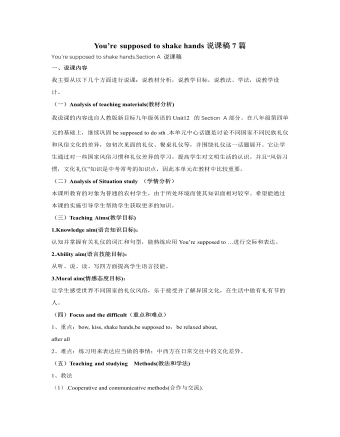
人教版新目标初中英语九年级下册You’re supposed to shake hands说课稿7篇
二 、教材分析本单元主要是通过对一些国家的风俗习惯、礼仪差异、时间观念和饮食文化的学习,进一步提高学生对文明生活的认识;加深学生对中外文化的了解,拓展学生的文化视野,为学生阅读相关方面的文章奠定一定的文化基础。我们知道近几年来有关风俗文化,生活习惯的 阅读内容一直是中考热门的话题之一。通过本单元的学习,学生可以掌握一定的相关方面的知识,为今后在阅读积累必要的信息。在Section A 当中出现的 be supposed to 句型为重点句型,此句型的语法结构为被动语态。被动语态也是历年来中考基础命题必考的内容之一。比如,去年的中考试题,在基础选择部分试题中就出现了对此语法结构考查。Section A 首先通过一些图片和句型来让学生初步了解本单元的语言目标。然后,通过练习进一步加以巩固。接着通过一组听力练习,来训练学生的听力,同时,学生可以具体了解到不同的国家在风俗习惯等方面有着怎样的不同。为下面的学习进行铺垫,同时激发学生了解更多的相关知识的学习兴趣。

人教版新目标初中英语九年级下册You’re supposed to shake hands教案
教学目标:1. 掌握本单元一些重点词汇的写法和用法。2. 学会自如谈论餐桌礼仪。Step 1 RevisionAsk some students to retell the customs at the table in France in the passage in 3a.Step 2 Self checkPart 1. Fill in each bland with the correct word given. Students do the exercises by themselves at first. Then check the answers. Ask the students to comprehend the sentences and help them point out uses of some words, like “arrive (at / in) sw., spend time / money on sth , spend time / money (in) doing sth.”Part 2. Read about Fan Ling’s experience in a western restaurant. Understand the passage. Point out some key points in the passage.1. be / get used to doing sth. 习惯做某事2. begin with = start with 以….开头3. crowd v. 挤满,塞满 the crowd 人群 crowded adj. 拥挤的Then students discuss about how she would solve her problem. Ask some to share their stories with others.Part 3. Complete the crossword by looking at the sentences on the left. Then check the answers.
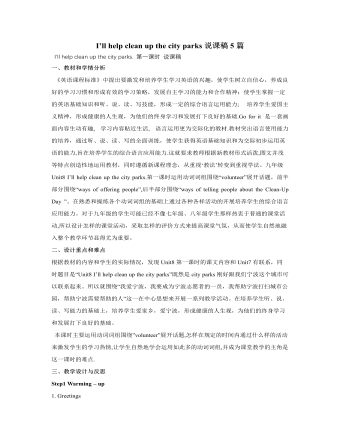
人教版新目标初中英语九年级下册I’ll help clean up the city parks说课稿5篇
二、教法学法1、任务型教学法:每个教学环节都是围绕着如何完成一个教学任务来设计的。2、感悟法:创设语境,让学生在一定的语言环境中感悟语言内涵,从而实现悟中学的目的。只有学生自己悟出的东西才能较好地内化为自己的东西。3、合作点拨法:通过教师创设的学习氛围,设置问题和反思质疑,推动师生,生生间的合作探究,小组合作学习,在解决问题中完成教学目标。以培养他们的合作探究的意识与精神。三、教学程序1 导入新课利用课件中的图片导入:在大屏幕上出示汶川大地震中一些悲惨的图片,让同学们说出汶川,然后老师说as well-know a stong earthquake happened in wenchuan,so many kind people go there to help others.再出示一些军人,医疗工作者,志愿者忙碌的身影,特别是温家宝总理看望受伤的孩子,让同学们知道一方有难,四方支持,帮助困难中的人是很有意义的。然后说Would you like to help others?What would you like to do?
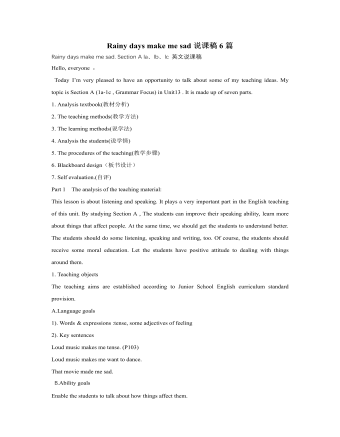
人教版新目标初中英语九年级下册Rainy days make me sad说课稿6篇
Today I’m very pleased to have an opportunity to talk about some of my teaching ideas. My topic is Section A (1a-1c , Grammar Focus) in Unit13 . It is made up of seven parts.1. Analysis textbook(教材分析)2. The teaching methods(教学方法)3. The learning methods(说学法)4. Analysis the students(说学情)5. The procedures of the teaching(教学步骤)6. Blackboard design(板书设计)7. Self evaluation.(自评)Part 1 The analysis of the teaching material:This lesson is about listening and speaking. It plays a very important part in the English teaching of this unit. By studying Section A , The students can improve their speaking ability, learn more about things that affect people. At the same time, we should get the students to understand better. The students should do some listening, speaking and writing, too. Of course, the students should receive some moral education. Let the students have positive attitude to dealing with things around them.1. Teaching objectsThe teaching aims are established according to Junior School English curriculum standard provision.A.Language goals 1). Words & expressions :tense, some adjectives of feeling 2). Key sentences Loud music makes me tense. (P103)Loud music makes me want to dance.That movie made me sad.B.Ability goals Enable the students to talk about how things affect them.Emotion & attitude goals Enable the students to understand the effect of things upon them.
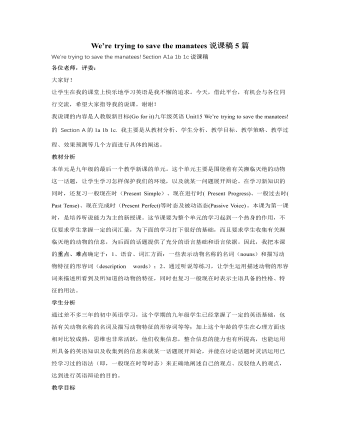
人教版新目标初中英语九年级下册We’re trying to save the manatees说课稿5篇
教材分析本单元是九年级的最后一个教学新课的单元。这个单元主要是围绕着有关濒临灭绝的动物这一话题,让学生学习怎样保护我们的环境,以及就某一问题展开辩论。在学习新知识的同时,还复习一般现在时(Present Simple)、现在进行时( Present Progress)、一般过去时( Past Tense)、现在完成时(Present Perfect)等时态及被动语态(Passive Voice)。本课为第一课时,是培养听说能力为主的新授课。这节课要为整个单元的学习起到一个热身的作用,不仅要求学生掌握一定的词汇量,为下面的学习打下很好的基础,而且要求学生收集有关濒临灭绝的动物的信息,为后面的话题提供了充分的语言基础和语言依据。因此,我把本课的重点、难点确定于:1、语音、词汇方面:一些表示动物名称的名词(nouns)和描写动物特征的形容词(description words);2、通过听说等练习,让学生运用描述动物的形容词来描述所看到及所知道的动物的特征,同时也复习一般现在时表示主语具备的性格、特征的用法。

北师大版初中数学九年级下册何时获得最大利润说课稿
(1)写出平均每天销售(y)箱与每箱售价x(元)之间的函数关系式.(注明范围)(2)求出商场平均每天销售这种牛奶的利润W(元)与每箱牛奶的售价x(元)之间的二次函数关系式(每箱的利润=售价-进价).(3)求出(2)中二次函数图象的顶点坐标,并求当x=40,70时W的值.在坐标系中画出函数图象的草图.(4)由函数图象可以看出,当牛奶售价为多少时,平均每天的利润最大?最大利润为多少?解:(1)当40≤x≤50时,则降价(50-x)元,则可多售出3(50-x),所以y=90+3(50-x)=-3x+240.当50<x≤70时,则升高(x-50)元,则可少售3(x-50)元,所以y=90-3(x-50)=-3x+240.因此,当40≤x≤70时,y=-3x+240.(2)当每箱售价为x元时,每箱利润为(x-40)元,平均每天的利润为W=(240-3x)(x-40)=-3x2+360x-9600.
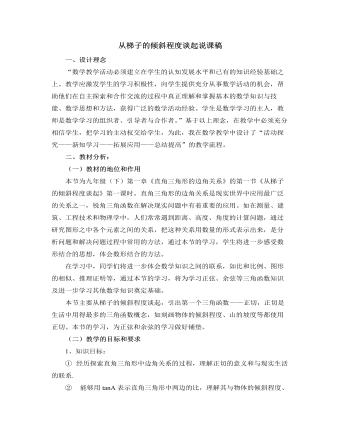
北师大版初中数学九年级下册从梯子的倾斜程度谈起说课稿
注意强调概念理解不到位的方面:① tanA是一个完整的符号,它表示∠A的正切,记号里习惯省去角的符号“∠”,若用三个字母表示角则“∠”不能省略,如“∠ABC的正切表示为tan∠ABC”;② tanA没有单位,它表示一个比值,即直角三角形中∠A的对边与邻边的比;③ tanA不表示“tan”乘以“A”。通过给出直角三角形的任两边的长,让学生求∠A,∠B的正切及时强化学生对概念的3、正切函数的应用理解通过实际问题的解答进一步了解梯子的倾斜程度、坡度与正切函数的关系;对学生进行正切的变式训练,让学生理解不管角的位置如何改变,只要角的大小不变则其正切值是不变的。练习的安插注意梯度,让不同的学生有不同的发展。4、最后小结本节课的知识要点及注意点五、达标测试具体思路:把几个问题分为四个等级,方便对学生的了解;通过评价让学生对自己的学习也做到心中有数。
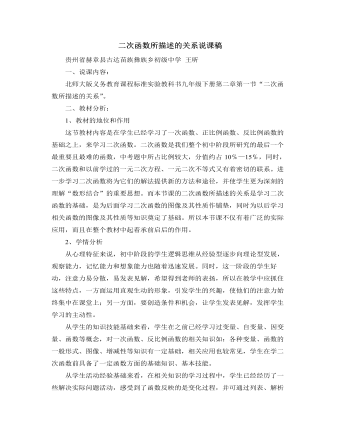
北师大版初中数学九年级下册二次函数所描述的关系说课稿
1、圆的半径是 ,假设半径增加 时,圆的面积增加 。(1)写出 与 之间的关系表达式;(2)当圆的半径分别增加 , , 时,圆的面积增加多少。【设计意图】此题由具体数据逐步过渡到用字母表示关系式,让学生经历由具体到抽象的过程,从而降低学生学习的难度。2、篱笆墙长 ,靠墙围成一个矩形花坛,写出花坛面积 与长 之间的函数关系式,并指出自变量的取值范围。【设计意图】此题稍微复杂些,旨在让学生能够开动脑筋,积极思考,让学生能够“跳一跳,够得到”。(六) 小结思考本节课你有哪些收获?还有什么不清楚的地方?【设计意图】让学生来谈本节课的收获,培养学生自我检查、自我小结的良好习惯,将知识进行整理并系统化。而且由此可了解到学生还有哪些不清楚的地方,以便在今后的教学中补充。(七)布置作业,提高升华必做题:课本P39-40随堂练习第1题,习题2.1第1题;
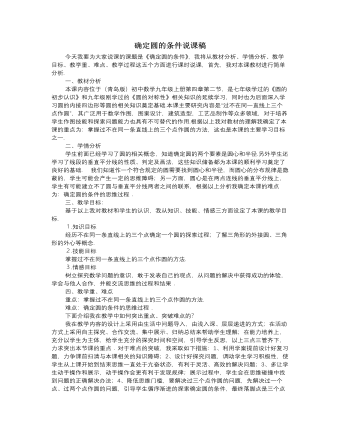
北师大版初中数学九年级下册确定圆的条件说课稿
设计说明:设计这组测验为了反馈学生学习情况,第1题较简单,也是为了让提高学生学习士气,体会到成功的快乐;第2题稍微有点挑战性,利用直角三角形外心位置规律解答,也满足不同层次学生的不同需求.教师可们采用抢答方式调动学生积极性,学生抢答,师生共同反馈答题情况,教师最后出示正确答案并做总结性评价.环节十:布置作业课件演示: 拓展延伸1.思考:经过4个(或4个以上的)点是不是一定能作圆?2.作业:A层 课本118页习题A组1,2,3; B层 习题B组.设计说明:设计第1题的原因保证了知识的完整性,学生在探究完三个点作圆以后,肯定有一个思维延续,不在同一直线上三个点确定一个圆,四个点又会怎样?四个点又分共线和不共线两种情况,不共线的四点作圆问题又能用三点确定一个圆去解释,本题既应用了新学知识,又给学生提供了更广泛地思考空间.第2题,主要是让学生进一步巩固新学知识,规范解题步骤. 在作业设计时,既面向全体学生,又尊重学生的个体差异,以掌握知识形成能力为主要目的.